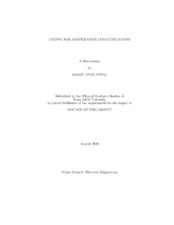Coding for Cooperative Communications
Abstract
The area of cooperative communications has received tremendous research interest
in recent years. This interest is not unwarranted, since cooperative communications
promises the ever-so-sought after diversity and multiplexing gains typically
associated with multiple-input multiple-output (MIMO) communications, without
actually employing multiple antennas. In this dissertation, we consider several cooperative
communication channels, and for each one of them, we develop information
theoretic coding schemes and derive their corresponding performance limits. We next
develop and design practical coding strategies which perform very close to the information
theoretic limits.
The cooperative communication channels we consider are: (a) The Gaussian relay
channel, (b) the quasi-static fading relay channel, (c) cooperative multiple-access
channel (MAC), and (d) the cognitive radio channel (CRC). For the Gaussian relay
channel, we propose a compress-forward (CF) coding strategy based on Wyner-Ziv
coding, and derive the achievable rates specifically with BPSK modulation. The CF
strategy is implemented with low-density parity-check (LDPC) and irregular repeataccumulate
codes and is found to operate within 0.34 dB of the theoretical limit. For
the quasi-static fading relay channel, we assume that no channel state information
(CSI) is available at the transmitters and propose a rateless coded protocol which
uses rateless coded versions of the CF and the decode-forward (DF) strategy. We
implement the protocol with carefully designed Raptor codes and show that the implementation suffers a loss of less than 10 percent from the information theoretical limit. For
the MAC, we assume quasi-static fading, and consider cooperation in the low-power
regime with the assumption that no CSI is available at the transmitters. We develop
cooperation methods based on multiplexed coding in conjunction with rateless
codes and find the achievable rates and in particular the minimum energy per bit to
achieve a certain outage probability. We then develop practical coding methods using
Raptor codes, which performs within 1.1 dB of the performance limit. Finally, we
consider a CRC and develop a practical multi-level dirty-paper coding strategy using
LDPC codes for channel coding and trellis-coded quantization for source coding. The
designed scheme is found to operate within 0.78 dB of the theoretical limit.
By developing practical coding strategies for several cooperative communication
channels which exhibit performance close to the information theoretic limits, we show
that cooperative communications not only provide great benefits in theory, but can
possibly promise the same benefits when put into practice. Thus, our work can be
considered a useful and necessary step towards the commercial realization of cooperative
communications.
Subject
Cooperative communicationsSource/Channel coding
Relay channel
Dirty-paper coding
Rateless coding
Slepian-Wolf coding
Low density parity-check codes
Raptor codes
Trellis coded quantization
Citation
Uppal, Momin Ayub (2010). Coding for Cooperative Communications. Doctoral dissertation, Texas A&M University. Available electronically from https : / /hdl .handle .net /1969 .1 /ETD -TAMU -2010 -08 -8475.


